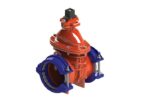Phosphorus is an essential component that exists in water bodies. However, when phosphorus levels in a water body reach abnormally high amounts, it can severely disrupt natural cycles and trigger a chain reaction of ecological imbalances. The excess nutrients can fuel algae blooms and potentially produce toxins, which can have devastating effects on aquatic ecosystems.

Lisa Brand – Chief Technology Officer and Co-founder of LG Sonic
For over 15 years, LG Sonic has established itself as a pioneer in ultrasonic algae control. With its cutting-edge technologies, LG Sonic has not only revolutionised algae management but has also taken proactive steps in monitoring and preventing the proliferation of this ancient life form. Now, LG Sonic is expanding its horizons by advancing the technology for real-time remote monitoring of phosphate levels.
The Importance of Phosphate Monitoring
Traditional phosphate level monitoring in water has historically relied on labour-intensive manual collection and subsequent expensive laboratory analysis. While this conventional method is generally reliable, it has inherent limitations that hinder its ability to provide a complete and dynamic view of nutrient levels within water bodies. This approach requires a significant allocation of human resources for manufacturing (labour) and imposes substantial financial burdens associated with laboratory testing and analysis (cost). These factors, in turn, create challenges in meeting strict environmental regulations and standards.
In response to these constraints, LG Sonic’s mission is centred on revolutionising the way we monitor phosphate levels. Their objective is to simplify and make this process more cost-effective, aligning it with rigorous regulatory requirements while alleviating the economic strain it typically entails.
LG Sonic’s innovative and integrated solutions aim to advance beyond the limitations of traditional manual methods. Their approach offers a more comprehensive and insightful understanding of how phosphate levels evolve over time and across different areas within water bodies. This newfound depth of knowledge ultimately contributes to more informed and sustainable management practices for aquatic ecosystems. In essence, their goal is to usher in a new era of phosphate monitoring that is both technologically advanced and environmentally responsible.
LG Sonic’s Phosphate Monitoring System
The LG Sonic Phosphate Monitoring system’s ability to collect data at various depths is made possible by its ingenious vertical water profiling function. This specialised mechanism is at the heart of the system’s capabilities, allowing it to operate autonomously and navigate vertically within the water column. This vertical mobility is a game-changer, as it permits the system to gather phosphate samples from not just the water’s surface but all the way down to the sediment layer.
The significance of this capability lies in its capacity to provide a holistic view of phosphate concentrations at different depths within the aquatic environment. This comprehensive data collection is instrumental for real-time monitoring, as it ensures that phosphate levels are continuously assessed throughout the water column. It’s like having a watchful eye on the entire ecosystem, enabling the early detection of any alterations in water quality.
This proactive approach to monitoring is of immense value, particularly in pinpointing the sources of nutrient pollution before they can escalate into more severe issues, such as the formation of harmful algal blooms. By detecting these concerns early on, the LG Sonic Phosphate Monitoring system contributes to the protection and preservation of water resources. In essence, it acts as a sentinel, tirelessly working to ensure the health and quality of our waterways.
Utilising Solar Power
The solar-powered capability of the LG Sonic Phosphate Monitoring system plays a pivotal role in enhancing its operational efficiency. This feature is particularly valuable because it ensures that the system operates without interruption, even in challenging environments such as large water bodies or in remote locations where conventional electrical connections are scarce or nonexistent.
It relies solely on the sun’s energy to power its operations, making it exceptionally versatile and self-sufficient. This self-reliance translates into continuous monitoring, a critical feature that allows the system to gather real-time data continuously.
Furthermore, the adoption of solar power brings substantial cost savings into the equation. The system doesn’t require daily maintenance checks, as it operates efficiently with minimal human intervention. Additionally, the elimination of electricity expenses further reduces operational costs, making the solar-powered LG Sonic Phosphate Monitoring system both economically and environmentally advantageous.
The Benefits of Real-time Phosphate Data
The LG Sonic Phosphate Monitoring system offers a remarkable level of convenience and accessibility for users seeking real-time phosphate data. This accessibility is facilitated by a seamless process wherein an in-situ lab efficiently processes the data and transmits it directly to the MPC-View software. This means that users can conveniently tap into the system’s wealth of information from virtually anywhere and at any time. Whether they are on-site or remote, this accessibility empowers users with the capability to stay well-informed about the precise state of phosphate levels in their water bodies.
Users can customize alerts and notifications to serve as a crucial tool for users aiming to stay ahead of water quality challenges. By defining specific thresholds and parameters for phosphate levels, users can establish a robust early warning system. Should the phosphate levels deviate from the desired norms, the system generates immediate alerts. These alerts serve as a proactive trigger, prompting users to take swift and well-informed actions to mitigate emerging water quality issues promptly.
The Significance of Cutting-edge Lab-on-chip Technology
Cutting-edge lab-on-chip technology is like the brain behind the LG Sonic Phosphate Monitoring system. This advanced technology facilitates controlled microfluidic interactions between samples and reagents, resulting in highly accurate phosphate readings. Such precision is pivotal in water quality management, as it allows for the detection of even subtle variations in phosphate concentrations, which can have substantial environmental consequences.
With an expansive linear detection range reaching 50 μM and a remarkably low limit of detection (LOD) at 0.1 μM for phosphate, LG Sonic’s platform surpasses conventional alternatives, ensuring unparalleled precision even in low-concentration scenarios.
But there’s more to this technology than just accuracy; it’s also a champion of efficiency. The lab-on-chip technology brings efficiency to the forefront of phosphate monitoring. By significantly reducing reagent consumption (up to 90% less than traditional methods), it not only conserves resources but also minimises waste production, aligning cost-effectiveness with environmental sustainability. This efficiency streamlines the monitoring process, reducing the need for frequent reagent replacements and making the system a practical and eco-friendly choice for long-term water quality monitoring.
LG Sonic’s Molybdate-Vanadate Method
The Molybdate-Vanadate method, often referred to as the Yellow method, employed by the LG Sonic Phosphate Monitoring system, is a remarkable technique that ensures precise and accurate measurements of phosphate levels. This method operates on a scientific principle wherein orthophosphate reacts with molybdate-vanadate in the presence of an acid to form a distinct yellow complex. This colour change is what allows the system to quantify phosphate concentrations effectively.
What sets the Yellow method apart and makes it special in the realm of phosphate monitoring is its sensitivity, accuracy, and selectivity. Moreover, the Yellow method is less susceptible to interference from other substances in the sample, ensuring that the measurements are highly specific to orthophosphate. This selectivity is crucial as it eliminates the risk of inaccurate readings due to the presence of unrelated compounds.
Furthermore, the Yellow method’s wide linear range, coupled with its precision and accuracy, makes it exceptionally well-suited for monitoring phosphate levels across a spectrum of concentrations.
LG Sonic’s Phosphate Monitoring represents the vanguard of environmental monitoring and sustainability. With its autonomous prowess, microfluidic precision, reliability, and cost-efficient design, it is poised to revolutionise the landscape of environmental data acquisition. Beyond compliance, it champions ecological preservation and digital intelligence.
LG Sonic’s innovation is born from the need to address environmental challenges, particularly the effects of excessive nutrient loading on aquatic ecosystems. These challenges include harmful algal blooms, oxygen depletion, and water quality deterioration, which all impact ecological health and human well-being. Their inspiration lies in the fusion of cutting-edge automation with remote accessibility. The intent is to render human intervention obsolete in the pursuit of continuous, high-fidelity data gathering, and instant remote data retrieval. This heralds a paradigm shift in how we perceive and harness water quality information.
Related articles:
Solving the Growing Problem of Phosphates in Water Treatment







